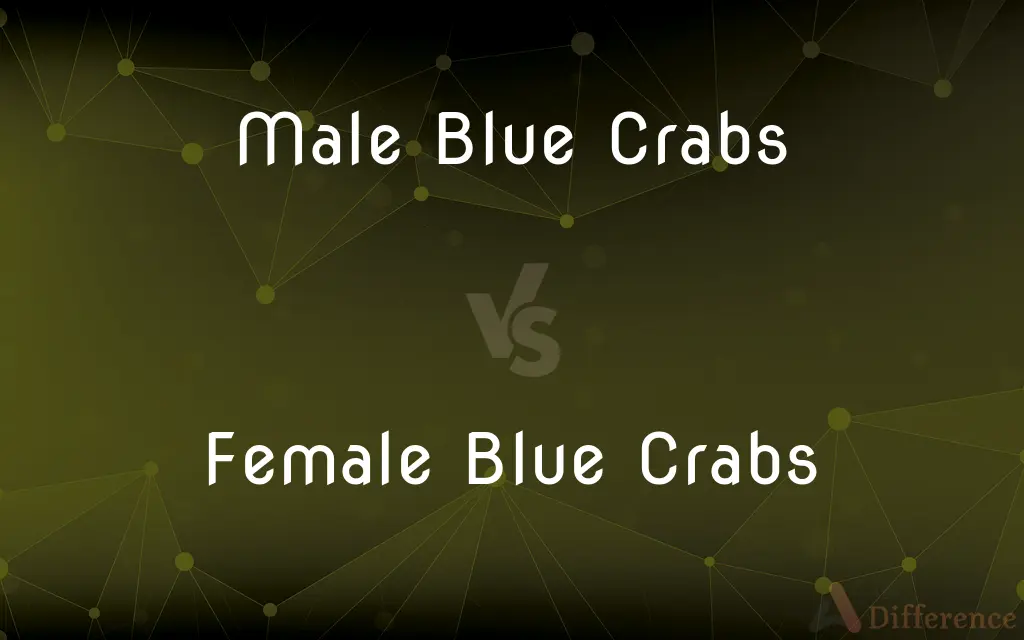Male Blue Crabs vs. Female Blue Crabs — What's the Difference?
By Tayyaba Rehman — Published on January 30, 2024
Male blue crabs have larger, more pointed aprons and blue claws, while females have rounded aprons, red-tipped claws, and are valued for their roe.

Difference Between Male Blue Crabs and Female Blue Crabs
Table of Contents
ADVERTISEMENT
Key Differences
Male blue crabs, also known as jimmies, are characterized by their bright blue claws and a distinctively shaped apron that resembles an inverted T or the Washington Monument. Female blue crabs, known as sooks, have red tips on their claws and a broad, rounded apron reminiscent of the Capitol dome.
The size of male blue crabs is generally larger than females, making them a popular choice for crab dishes due to more meat. Females, though smaller, are sought after for their roe (eggs), considered a delicacy and crucial for the species' reproduction.
In terms of behavior, male blue crabs are more aggressive and territorial compared to females. Female blue crabs, especially when carrying eggs, are known to be more elusive and protective of their brood.
In the culinary world, male blue crabs are often preferred for their size and meat quantity, especially in dishes where the meat is the focus. Female crabs, due to their roe, are prized in certain culinary traditions for the unique flavor and texture the roe brings to dishes.
Conservation practices often dictate different regulations for harvesting male and female blue crabs to ensure sustainable populations. The management of female crabs is particularly crucial due to their role in reproduction and maintaining the crab population.
ADVERTISEMENT
Comparison Chart
Apron Shape
Inverted T or Washington Monument-like
Broad and rounded, like the Capitol dome
Claw Color
Bright blue
Red-tipped
Size
Generally larger
Smaller
Culinary Preference
Preferred for meat quantity
Valued for roe
Role in Conservation
Subject to fishing regulations
Crucial in species reproduction
Compare with Definitions
Male Blue Crabs
Generally larger in size.
The male blue crab was chosen for its larger size for the crab boil.
Female Blue Crabs
Females have red-tipped claws.
The female blue crabs' claws were distinguished by their red tips.
Male Blue Crabs
More aggressive and territorial.
The male blue crabs were more dominant in the crab trap.
Female Blue Crabs
They have a broad, rounded apron.
The apron of the female blue crab indicated she was a sook.
Male Blue Crabs
Often preferred for their meat.
Chefs often request male blue crabs for their ample meat.
Female Blue Crabs
More elusive, especially when carrying eggs.
The egg-bearing female blue crabs were protected under conservation laws.
Male Blue Crabs
They possess a distinctively shaped apron.
The apron of the male blue crab resembled the Washington Monument.
Female Blue Crabs
Smaller but valued for their roe.
The female blue crabs were sought after for their flavorful roe.
Male Blue Crabs
Males have bright blue claws.
The male blue crabs were easily identifiable by their blue claws.
Female Blue Crabs
Crucial for species reproduction.
Regulations often protect female blue crabs due to their reproductive role.
Common Curiosities
Which is larger, male or female blue crabs?
Generally, males are larger.
Do female blue crabs have any unique behaviors?
They tend to be more elusive, especially when carrying eggs.
Why are female blue crabs prized in cooking?
For their roe, which is considered a delicacy.
Why are conservation practices important for female blue crabs?
They play a crucial role in reproduction and maintaining crab populations.
Are male blue crabs more aggressive than females?
Yes, males tend to be more aggressive and territorial.
Which blue crab is better for dishes requiring more meat?
The male blue crab.
Can the roe of female blue crabs be eaten?
Yes, it's a delicacy in many culinary traditions.
Is the meat of male blue crabs preferred over females?
Yes, often for its quantity and size.
What's the main visual difference between male and female blue crabs?
Males have blue claws and a T-shaped apron, while females have red-tipped claws and a rounded apron.
What color are the claws of a male blue crab?
Bright blue.
Are there different fishing regulations for male and female blue crabs?
Yes, often to protect the reproductive capabilities of females.
Why might chefs prefer female blue crabs in certain recipes?
For the unique flavor and texture their roe adds to dishes.
How does the size of female blue crabs affect their culinary use?
Their smaller size makes them less meaty, but their roe is highly valued.
Are male blue crabs territorial throughout the year?
They are particularly territorial during mating seasons.
Share Your Discovery

Previous Comparison
Simplex Transmission Mode vs. Full Duplex Transmission Mode
Next Comparison
Simplex Transmission Mode vs. Half Duplex Transmission ModeAuthor Spotlight
Written by
Tayyaba RehmanTayyaba Rehman is a distinguished writer, currently serving as a primary contributor to askdifference.com. As a researcher in semantics and etymology, Tayyaba's passion for the complexity of languages and their distinctions has found a perfect home on the platform. Tayyaba delves into the intricacies of language, distinguishing between commonly confused words and phrases, thereby providing clarity for readers worldwide.












































